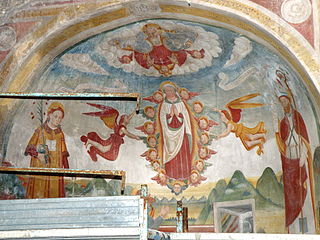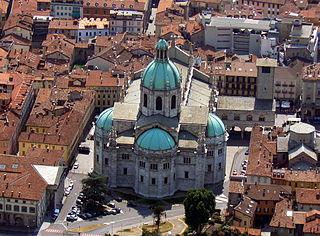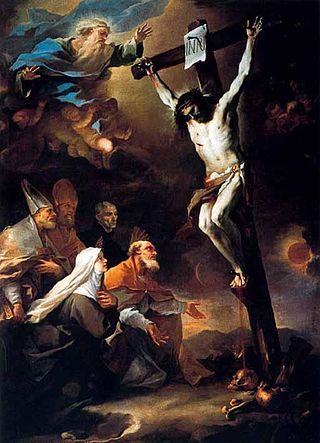
Saint Valentine was a 3rd-century Roman saint, commemorated in Western Christianity on February 14 and in Eastern Orthodoxy on July 6. From the High Middle Ages, his feast day has been associated with a tradition of courtly love. He is also a patron saint of Terni, epilepsy and beekeepers. Saint Valentine was a clergyman – either a priest or a bishop – in the Roman Empire who ministered to persecuted Christians. He was martyred and his body buried on the Via Flaminia on February 14, which has been observed as the Feast of Saint Valentine since at least the eighth century.

Abundius, venerated in the Catholic Church as Saint Abundius, was a bishop of Como, Northern Italy.

One of the first streams of Romanesque architecture in Europe from the 10th century and the beginning of 11th century is called First Romanesque or Lombard Romanesque. It took place in the region of Lombardy and spread into Catalonia and into the south of France. Its principal decoration for the exterior, bands of ornamental blind arches are called Lombard bands. It was characterized by thick walls and lack of sculpture in facades, and with interiors profusely painted with frescoes.

San Siro is a comune (municipality) in the Province of Como in the Italian region Lombardy, located on the west shore of Lake Como immediately north of Menaggio and south of Cremia.
Zuglio is a comune (municipality), former bishopric and Latin Catholic titular see in the Regional decentralization entity of Udine in the northeastern Italian autonomous region of Friuli-Venezia Giulia, located about 110 kilometres (68 mi) northwest of Trieste and about 45 kilometres (28 mi) northwest of Udine, in the Val Bût.

Eustorgius I was bishop of Milan from 343 to about 349. He is honoured as a Saint in both the Catholic Church and the Eastern Orthodox Church. His feast day is on the September 18.

Saint Syrus of Genoa was a priest and later bishop of Genoa during the fourth century AD.

Saint Himerius of Bosto is venerated as a pilgrim and martyr. He is venerated in the province of Varese jointly with Gemolus (Gemolo), who was martyred with him.

Fidelis of Como was an Italian soldier-saint, according to Christian tradition.

Maternus was Archbishop of Milan from c. 316 to c. 328. He is honoured as a Saint in the Catholic Church and his feast day is on July 18.

The Basilica of Sant'Abbondio is a Romanesque-style 11th-century Catholic basilica church located in Como, region of Lombardy, Italy.
Saints Felinus and Gratian(us) (sometimes Gratinian(us)) (d. 250 AD) are venerated as martyrs by the Catholic and Eastern Orthodox churches. They are patron saints of Arona, near Milan, where their relics were enshrined.

Calimerius was an early bishop of Milan. He is honoured as a Saint in the Catholic and Eastern Orthodox churches and his feast day is on July 31.
Saint Getulius is venerated together with Amantius (Amancius), Cerealus (Caerealis), and Primitivus as a Christian martyr and saint. They are considered to have died at Gabii. According to tradition, Getulius was the husband of Saint Symphorosa. Getulius is a name meaning "of the Gaetuli", which was a tribe of North Africa.

The Diocese of Como is a Latin Church ecclesiastical jurisdiction or diocese of the Catholic Church in northern Italy. It was established in the Fourth Century. It is a suffragan diocese in the ecclesiastical province of the metropolitan Archdiocese of Milan. The Bishop of Como's cathedra is in the Como Cathedral.

Aspren or Asprenas was a 1st-century Christian saint and venerated as the first Bishop of Naples.

Quirinus is venerated as an early bishop of Sescia, now Sisak in Croatia. He is mentioned by Eusebius of Caesarea.

Gambarogno is a municipality in the district of Locarno in the canton of Ticino in Switzerland. It was created on 25 April 2010 through the merger of the municipalities of Caviano, Contone, Gerra, Indemini, Magadino, Piazzogna, San Nazzaro, Sant'Abbondio and Vira.

Anathalon was the first recorded Bishop of Milan and lived at the end 2nd-century or early 3rd-century. A later tradition made him the also the first bishop of Brescia. He is honoured as a saint in the Catholic and Eastern Orthodox Churches, which celebrate his feast day on 24 September. In Milan, however, this is commemorated on 25 September.

The Basilica of San Fedele in Como is located in the city center. The present Romanesque church dates from 1120 and is dedicated to the Fidelis of Como.